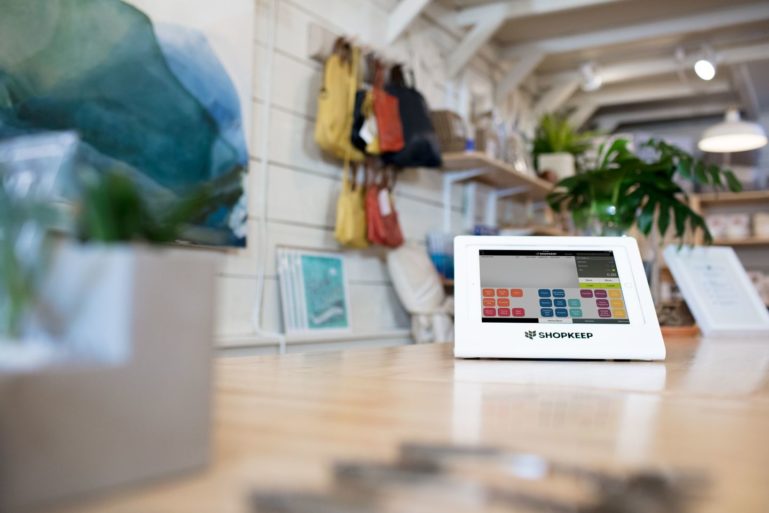
A Cheater’s Guide On How To Choose A Cash Register
A cash register has been and continues to be a necessity for brick-and-mortar stores. Small businesses up and down Main Street have been using cash registers for more than a century.
The types of cash register systems available to merchants may have come a long way since the days of Mr. James Ritty, but they’re still the one item retail stores can’t do without. Whether it’s a simple electronic cash register (ECR), a cash register app on an iOS or Android device, or a sophisticated point of sale (POS) system, every storefront needs a way to process transactions.
The best cash register for a small retail business is one that works for you. So, if you’re wondering how to choose a cash register that’s simple, easy to use, and the right fit for your business, here are a few things to consider before you make a purchase.
What Is Your Business Plan?
Before you can settle on the right cash register for your small business, you’ll need to revisit your business plan. Some merchants open a small operation and intend to stay that way. If you’re a business with extremely limited inventory and inconsistent sales volume, a cash register might be enough to get by. However, if your inventory is larger, more complex and you may want track the items you’re selling and save time on inventory management, a cash register isn’t going to cut it. In the case of the latter, comprehensive POS is undoubtedly the better option. What does your business plan look like? If you have lofty goals, you’ll want a solution that can support them.
You’ll also want to consider the number of inventory items you carry. If you only sell a handful of products, then a simple cash register is a budget-friendly way to start selling. On the other hand, if you have hundreds or thousands of inventory items that you need to track, a point of sale system with inventory management features would be the better choice.
Lastly, what does your budget look like? While a POS system may be nice to have, it’s going to cost more than a cash register. If you’re a new business just starting out, you may only have a very limited budget for a point of purchase solution, and that’s okay.
Besides, you’re busy getting up and running so sometimes it’s easier to get a cheap cash register now and make the real decision later. You can do all the planning in the world, but until you’re open for business, there are still a lot of what-ifs up in the air.
For example, you may think that because you only have an 800 square feet of retail space that you only need, and have room for, one cash register. Once customers start coming in, you may quickly realize that a second checkout is necessary.
Starting out with a cash register can help you identify your needs, pain points, and what problems you’d like a point of sale system to solve. Then, if and when you decide to upgrade, you’ll already know the key features to look for.
SEE ALSO: Choosing A POS System: Your 90-Day Plan
Receipt Printers: Thermal Or Ink?
The nice thing about classic cash registers is they have a built-in receipt printer, and more often than not, it will be on the left-hand side. A receipt can print using one of two methods: ink ribbons or a heat source known as thermal printing.
Thermal printers don’t require ink because they use a special paper that is coated with a heat-sensitive material known as thermal paper. This paper reacts to the thermal print heads to produce the images on paper. The lack of ink makes them a low-maintenance, cost-effective option compared to ink printers.
However, have you ever had a receipt in your wallet so long that the writing wears off? Yep, that’s thermal paper. As time goes on, the imprint begins to fade and becomes illegible; which makes issuing a return more challenging.
The other downfall of thermal printers is an environmental one. Will your retail space experience extreme temperatures? Extremely hot environments may cause the printer to overheat and produce a very dark, charcoal-looking image. Think of it as an underexposed photograph that is very dark and lacks detail.
On the flipside, frigid temperatures may cause the receipt to print a very faint image. Like an overexposed picture that lacks details and looks washed out. With ink ribbon printers, heat is not a factor in the printing mechanism. Therefore, temperatures won’t affect the receipt readability.
The ribbons come as one cartridge with a black ribbon and a red ribbon. Although they’re shaped different than the ink cartridges used for your home computer printer, the concept is similar. You drop an ink ribbon in, print until it runs out and it’s time to swap it out for a new one.
The downside to ink-based printers is the cost of the ink. Depending on the specifics, a cartridge may only set you back a few dollars, but over time that will easily add up to a couple hundred dollars or more depending upon your transaction volume.
The 3 Cs: Cash Drawers, Credit Cards, And Customer Displays
Cash drawers are an essential part of a complete cash register system. But what you may not realize is they come in various sizes, configurations, and security levels. Small cash drawers are 13” (W) x 13” (D) while larger ones are 18” (W) x 16” (D). The size will depend on the number of the available bill and coin slots.
The size of the drawer may vary, but you’ll always find a key lock as a security feature. Some cash drawers will have a media slot or two. This will allow you to store $50 and $100 bills, checks, and credit card slips securely.
That leads us to our next point, credit cards. Since a cash register is just a cash register, you’re going to need an external credit card terminal to process credit and debit cards. And if the terminal can also accept NFC payments like Apple Pay, you get bonus points.
Even though you’re only in the market for a cash register, it makes sense to give customers the option to pay with plastic. In a recent survey, 80 percent of respondents use their debit card to pay for everyday purchases. In an increasingly cashless society, giving your customers payment options is only going to work in your favor.

It’s also important to note that not all ECRs and credit card terminals will work in perfect harmony. Cash registers are programmed to work with specific credit card readers, so you want to make sure the devices you choose are compatible with one another. The best way to do this is to purchase your cash register and credit card terminal from the same vendor.
While credit cards are optional, customer displays may not be. Although the laws vary across state and local jurisdictions, California law requires the price of each item to be conspicuously displayed to the consumer at the point of purchase.
Most cash registers will come with a built-in, pop-up customer display that can rotate to provide the best viewing angle for customers. We urge you to check your local laws to ensure the cash register system you choose is up to code. It’s also a nice-to-have from a customer perspective. Think of it as their security measure for keeping you honest.
Faster Checkouts With Barcode Scanners
Customers may like to watch you ring up their items, but they don’t want to spend all day in the checkout line. The quickest and most accurate way to keep the lines moving is using a barcode scanner.
Not all cash registers will be compatible with a barcode scanner. However, if you have more than a few dozen inventory items, we suggest you invest in a register that works with a barcode scanner.

A Cash Register That’s Easy To Use And Gets The Job Done
We saved the best for last because it’s the most important. Above all else, find a cash register that is easy to use and does the job you need it to do.
Like we mentioned in the beginning, over the years, cash registers have taken on various forms. You have entry level cash registers that are nothing more than a glorified calculator or adding machine with a cash drawer attached to it. For small or micro businesses, that might be all you need. A simple device that can track sales is a good place to start and get your feet wet.
For those that need a few more features and functionality like an LCD display, more item keys, and barcode scanning capabilities, a cash register that offers a lite software program via an SD card would be the better choice for you. It will provide local inventory management of SKUs and even integrated payment processing, so your cash register and credit card terminal are working in tandem.
A modern twist on that type of device would be cash register app. Sometimes referred to as a cash register POS app because of its advanced features like reporting, analytics, and data, this type of app would have all the same abilities mentioned above, plus more. However, it runs on a tablet or smartphone, like an iPad cash register or Android device. The beauty of a cash register app is that touchscreen tablet technology is something everyone is familiar with. Therefore, the learning curve of a cash register app will be significantly less than that of a traditional cash register. This familiarity can save you valuable time (and money) when it comes to training employees.
SEE ALSO: Need A Cash Register? There’s An App For That
Lastly, make sure you find a cash register system that’s easy to use for everyone. As a business owner, you may mostly use the cash register to retrieve data such as drawer and shift totals. Employees mostly use it to ring up sales or returns. Regardless of who and how you’re interacting with the register, make sure everyone can quickly grasp the necessary functions to perform their job.
Learning how to choose a cash register for your business doesn’t need to be complicated, it just needs to be well thought out. Hopefully, this cheat sheet will help guide you in the right direction. Now get out there and start looking for the best cash register for your small business!
Want to try ShopKeep for yourself?
Just answer a few easy questions.
Need help finding the right point of sale?
Just complete the form. We’ll call you right back to explain how ShopKeep can work for you.
Hit the ground running.Sprinting, in fact!
Read our free, comprehensive guide, Small Business 101, to learn all you need to know about starting a thriving business.

